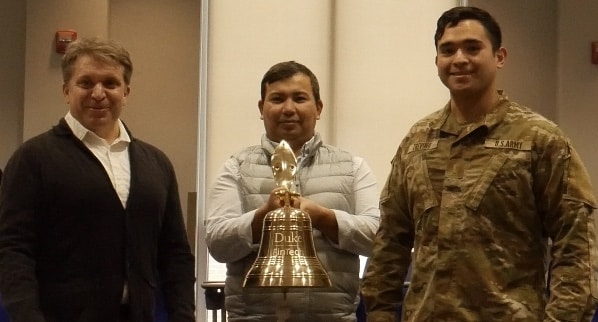Calculated Risks, Real Results: Duke FinTech’s 2025 Trading Competition
After a fierce competition, the winners of the 2025 trading competition share their experience.

Every year, the Duke FinTech hosts a free trading competition for university students and those affiliated with the United States Military where they get to simulate being a professional trader and show the world their trading skills. Through the IBKR Student Trading Lab and Interactive Brokers platform, traders are given $1 million in simulated currency that they can trade for equities, fixed income, derivatives, ETFs, cryptocurrencies, and other products offered by Interactive Brokers. The platform allows traders to make informed trades using real-time streaming market data and use the same user interface/features professional traders do. While traders wheel and deal on the simulated trade floor, they are scored based on their sharpe ratio, which is their risk-adjusted return. This metric considers the trader’s average rate of return (how much money they made) and the volatility (the risk they took) of the returns. Whoever has the highest sharpe ratio at the end of the competition wins.
This year, Duke FinTech kicked off the competition with an Installfest at Duke University, in which traders got to meet The Architect (Professor Jake Vestal) and install all the appropriate software for the competition. Traders from all walks of life got to connect before the competition started, as well as compare strategies. A week later, the competition started with an experimental phase. Traders were able to practice with Interactive Brokers’ Trader Workstation, as well as ask for a reset of their account if they did not like their positions. While the traders were not scored during this time, it allowed them to create strategies and experiment with the features Interactive Brokers has.
After a week of experimental trading, The Architect (Professor Jake Vestal), Nurken Abeuov, and The Artilleryman (Mario Trevino) ran the ceremonial bell, marking the start of the competition. From February to May, the traders navigated the market’s ups and downs, make strategic trades in hopes of getting one of the top three spots. In the end, traders by the names of Asprose (Junjie Li, Jiaxin Zhao, Huizhe Wang), Duc Thanh (Timothy) Nguyen, and 161803 (Leonard Yang) placed first, second, and third respectively.
The top three traders had their ups and downs throughout the competition. While the market correction in February of 2025 took out some competitors, the top three kept their sharpe ratio above 0.02. In March, Asprose’s sharpe ratio quickly dropped below 0.02 while the other top three, Duc Thanh (Timothy) Nguyen (second place) and Leonard Yang (third place) held sharpe ratios in the 0.05 and 0.1 range. It seemed that they had knocked out of the competition.
Trader Name: Asprose, Affiliation: Duke FinTechWe encountered data latency issues with approximately 15-minute delays that required strategic adjustments to our execution approach. In retrospect, we recognize that quantitative methodologies may not have provided significant advantages…
As the competition continued, Duc Thanh (Timothy) Nguyen continued to dominate the top spot for weeks while Leonard Yang was fighting with another competitor to place in the top three. Eventually, Leonard Yang was able to overtake their competitors and held on to the third-place spot.
Trader Name: 161803, Affiliation: Duke UniversityI’ve always believed in this phrase when investing: ‘Calculated risk, optimized reward—volatility is the cost, conviction is the edge.’ I leveraged on this phrase to win big, gaining massive returns…
While it seemed Duc Thanh (Timothy) Nguyen would end up placing first, in the last month of the competition, team Asprose made a comeback, shooting up to a 0.2 sharpe ratio. They were able to hold close to a 0.2 sharpe ratio for the rest of the competition, winning them first place. Duc Thanh (Timothy) Nguyen then found himself in the race for second, in which he won over 161803 by a 0.01 difference in sharpe ratio.
Trader Name: Duc Thanh (Timothy) Nguyen, Affiliation: Boston UniversityOne guiding quote I often return to is from Howard Marks: ‘You can’t predict, but you can prepare.’ That mindset drove my attention to risk metrics…as much as to raw portfolio gains. This experience deepened by appreciation for the interplay between macro conditions, sector rotation, and cross-asset volatility, and how structured decision-making under uncertainty is at the heart of professional trading.
After the competition results were released, the traders were gifted their own “trader’s bell” with their name engraved on it.
These traders would not have been successful without blending the theory with the practicality of trading, which at the core of the Duke FinTech program. Through blending the theory with the practical, the Duke FinTech program equips students with the skills to lead financial innovation and see success across multiple industries. Additionally, the program is committed to educating students of all walks of life, including those who are working professionals or military affiliated. Whether is it starting a one-year track (the accelerated program) for working professionals or opening the trading competition to those affiliated with the armed forces, Duke FinTech is committed to creating professionals who bridge the gap between finance and technology.
Congratulations again to our winners and all those who participated in the 2025 Duke FinTech Trading Competition. If you would like to learn more about the trading competition, please visit fintechtradingcompetition.com.
The IBKR Student Trading Lab is a free online resource for educators looking to blend finance or computer science classwork with real-world trading experiences. Program registration is easy for educators, and once their account is set up, invitations can be sent to students to open their own paper trading accounts. Each student receives a paper trading account with a full complement of trading tools and starts with USD 1,000,000 in paper trading equity. Account equity fluctuates as if trades were executed in the real market.
